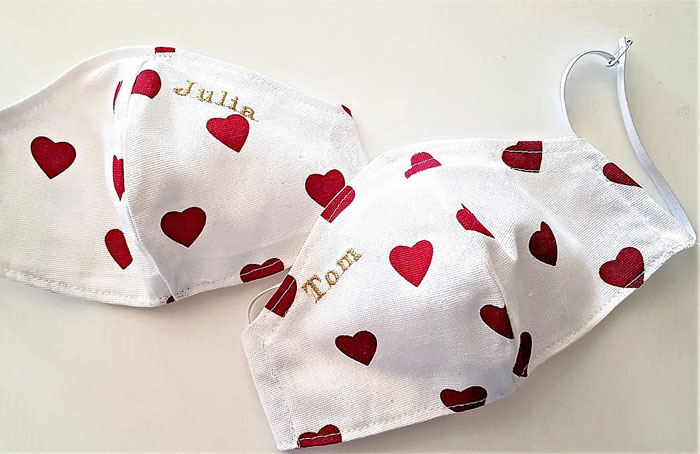Redesigning Wedding Ceremonies for 2020
Categories: | Wedding Ceremony | Wedding Rituals |
 Ever-changing
COVID-19 rules and guidelines around weddings
have made it clear that weddings are considered a
high risk for transmission. As the celebrant, I have
responsibility for what happens during the ceremony,
and that includes the safety of the couple and their
guests.
Ever-changing
COVID-19 rules and guidelines around weddings
have made it clear that weddings are considered a
high risk for transmission. As the celebrant, I have
responsibility for what happens during the ceremony,
and that includes the safety of the couple and their
guests.While developing my own COVIDSafe plan for the ceremonies I officiate it became very clear just how many parts of the ceremony now need a different approach in order to keep everyone safe. So I've been working on developing new safer adaptations that don't compromise the emotion of the occasion.
I've also taken into account the government rules, regulations, and guidelines, together with advice that social (physical) distancing is not expected between people who live in the same household.
Important: If no-one attending your wedding has COVID-19, then there is no risk of transmission. The problem is that a person can be pre-symptomatic but infectious, or asymptomatic and infectious, so the wise course of action is to ask your guests not to attend if they are unwell or have any respiratory or COVID-19 symptoms and to:
- alert your guests ahead of time that all social distancing guidelines will be adhered to at your wedding and that you will also have infection control protocols in place, eg provision of hand sanitising stations plus small bottles of hand sanitiser on each seat
- alert guests that their contact details will
be collated and kept for the required period of
time
- ask guests to bring their own pen to sign your
guest book, or better still, ask them to send
you virtual messages of love to print out to
create your own guestbook
- ensure all surfaces that you and anything
required in the ceremony may come into contact
with are thoroughly cleaned before the ceremony
- avoid the throwing of petals, confetti, etc or the blowing of bubbles.
- live-stream your ceremony for your guests who
are unwell or feel uncomfortable attending
Seating
Where you have decided to provide limited seating for selected guests or have all guests standing consider applying the family bubble grouping to where people are standing. If in your own backyard the spray that landscapers use to mark out the ground works well - and comes in blue, so could be your something blue!
Positioning
Traditionally, the wedding party (bridesmaids, groomsmen, etc) is deployed, standing quite close to one another, on either side of the couple. Bigger bridal parties will need to be assessed and positioning adjusted, taking into account whether or not the individuals are part of a bubble or not.
The walk down the aisle
Best practice to ensure great photos of the bridal party entrance is to ensure 3 to 6 metres between each person in the processional. That more than meets social distancing guidelines. Where care needs to be taken is when they line up ready to make their entrance and what happens at the end of the aisle when they move to take their places for the ceremony.
Music and singing
While transmission of COVID-19 has been recorded within choirs and other group singing events, so far none has been recorded where the vector of transmission as been the Great Highland Bagpipe. Dr Robert Gray, Senior Fellow and Consultant Respiratory Physician at the University of Edinburgh, a piper himself, only 2 weeks ago expressed the view that the bagpipe is a reservoir for viruses from respiratory secretions and are therefore mouth-blown bagpipes are more risky than other musical instruments. Because, however, the sound of the bagpipe can be heard from some distance away, judicious positioning of a piper at an outdoor ceremony should pose little risk to others.
Participation in the
ceremony
The ring exchange
Rituals (mini or
sub-ceremonies)
- Handfasting
Handfasting usually involves people handling the cord(s) or ribbon(s) and standing close to the couple while tying their hands together. To minimise the risk - Have the tying done by a member of your household
- Do the tying yourselves. While this will require a complete change in mindset and some nifty choreography, it is not only doable but can add much to the symbolism and meaning of this ritual.
- Honey Ceremony
While honey is sterile and anti-bacterial, fingers are not. So the cultural custom of the couple dipping their little finger (pinky) into honey and touching it to one another's lips, is risky as there is always a risk that they may have inadvertently touched a contaminated surface between washing their hands and participating in the ritual.
- If you wish to stick with tradition and use your fingers, thoroughly sanitise your hands immediately before carrying out the ritual
- Use separate spoons - small demitasse spoons are ideal, but teaspoons would do
- Loving Cup/Wine Ceremony
Sharing of food and drink is actively discouraged, for example, the cake you ceremonially cut cannot be shared with the guests, and buffets and grazing tables where food and serving utensils can be contaminated are banned. As normally carried out, a Loving Cup or Wine Ceremony involves the couple drinking from the same vessel. As you will most probably already be living together, sharing a drink would appear to pose no added risk as long as other people don't handle it. However, if your wedding is being held in a venue or restaurant, I strongly advise that you adhere to the rules, avoid the shared Loving Cup ritual and adapt the Wine Ceremony
- Blend the wine, pouring the white and red
wine into a jug which you the use to pour into
two glasses so you each drink from your own
glass. A slight tweak to the narrative is all
that is needed.
- Ring warming
Because a ring warming maximises contact between the guests and of the guests with the rings and/or the container in which they are passed around, is a high-risk ritual as it is usually carried out. However, it can be adapted to minimise the risk
- Restyle it as a ring blessing where, just before you exchange your rings you holds them up for the guests to see and while I ask everyone to focus on the rings as they make a silent wish or say a silent prayer for the marriage
- Have one person, preferably a member of your
bubble, warm and bless the rings on behalf of
everyone having immediately prior sanitised
their hands
- Rose ceremony
There are two broad versions of the Rose Ceremony - either the couple exchanges roses or they present them to others, usually their mothers, as an expression of gratitude. Generally speaking the roses are laid on the signing table until it is time to give hand them to you to either exchange or hand to your mothers.
- Place the roses in a long florist box or in a narrow vase to minimise the risk of a third party contaminating the roses
- Allow your mothers to take a rose out of the
box rather than handing them to them.
- Sand ceremony
A Sand Ceremony requires very little adaptation to make it COVID-19 safe. - Sanitise all the containers before placing them on the table
- If involving additional people, have them come forward one at a time
- Provide a box to place the containers in
after the ceremony plus hand sanitiser for the
person who packs them up.
- Unity Candle
The Unity Candle ritual traditionally involves a member of each family (usually the mothers) lighting a taper candle on either side of the Unity Candle which is then lit by the marrying couple, each using the taper candle lit by their mother. Minor adaptation would be all that is necessary. - Provide two lighters or boxes of matches so
your mothers do not have to share
- Have your mothers come forward to stand on either side of the table, at a distance, and step forward to light a taper one at a time rather than together
- As your mothers do not have to touch the tapers, there is no need to sanitise them after your mothers have lit them, however care needs to be taken not to contaminate the candles when placing them in the candle holder.
The Kiss, and kissing and
hugging in general
Witnesses and the signing
of the register and certificates
Microphones
Masks
Social distancing badges
Contact Tracing Record
Thanks for reading!

you 0 Things